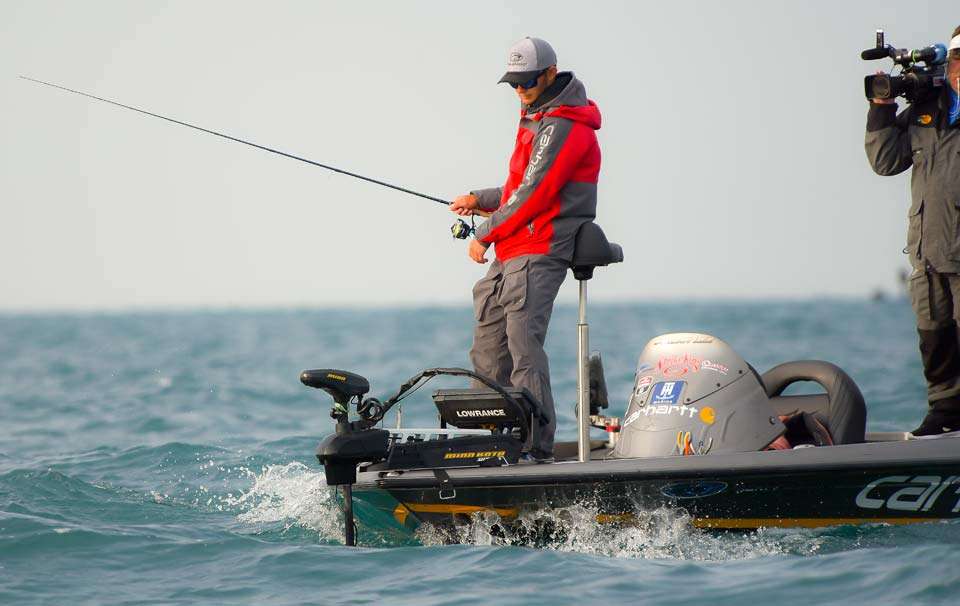
The back-story of Carhartt’s entry into fishing apparel began like many ideas. It started with employees swapping fish stories in the office hallways of company headquarters in Dearborn, Mich.
Fish tales turned to business and the talk moved from outside the hallways and into the meeting rooms. The focus eventually shifted back outside to seek feedback from other anglers and a brand was born.
Carhartt’s work-wear popularity dates back 128 years to the beginning of the company in 1889. Carhartt eventually recognized that fishing and hunting were popular hobbies for customers. Many punched time cards at job sites and headed into the woods or waters wearing the same clothes.
Then along came what was loosely known in the hallways as “The Secret Hunting Society.”
“We have a lot of employees with an internal passion for the outdoors,” said Tim Humes, brand manager, outdoors. “We had wild game lunches, got together and talked mostly hunting, some fishing, like anyone else who enjoys the sport.”
The idea to move forward with fishing clothes happened like it always does with new products at Carhartt. That is slowly, deliberately and from the outside in.
Editor’s note: See some of Carhartt’s brand history.
“We started seeing photos on social media posted by our customers who went fishing,” explained Humes. “Through research we discovered our consumers are more than 1,000 times more likely to go fishing than the average consumer.”
Carhartt actually entered the hunting clothing market in the early 1900s. In the past decade, technical clothing came about through advances in fabric and technology. Carhartt Force Extremes, Rain Defender, Storm Defender and Stain Breaker are among a dozen terms used to define how the technology functions in garments.
Lightweight, functional clothes with moisture wicking fabrics that cool or warm are the norm today. Those advancements played a key role in the next level taken by Carhartt in the outdoor market.
A rain jacket and bibs that could pass the rigid test of Carhartt’s work wear while fitting the technical clothing needs of anglers was among the goals.
“The fishing clothes had to pass our extremely high standards for work clothes,” said Harry McPherson, senior category manager, men’s outerwear and accessories. “It all had to pass abrasion tests, all of the durability standards of our workplace garments.”
As momentum picked up, Carhartt added professional anglers to the mix of product testers and reviewers it already had involved in providing feedback. A partnership was formed in 2011 with B.A.S.S. and progress continued.
“We noticed the pros wearing rain suit bibs all day long, even when it wasn’t raining,” said McPherson. “That’s when we realized we really needed to pay attention to their needs, because they were respected by the average angler.”
Coincidentally, that was how Hamilton Carhartt turned failure into success. He initially designed a work bib based on what he thought factory workers needed. The lesson learned came after he gathered better design ideas straight from the factory floor.
The feedback from anglers began to gain traction with the design and product teams. Carhartt combined the needs of anglers with its highly respected and successful knack for designing and making workplace garments. Combining the better of two worlds became the end result.
“A work shirt that catches and binds with a hammer stroke is equally restrictive as what to happens when a pro angler casts all day long,” explained McPherson. “We looked at both our consumers to find the best fit for the rain gear.”
The product development teams made such discoveries by getting into the boats of the likes of Matt Lee, Jordan Lee and Mark Zona.
“Having our team get into a bass boat running 60 mph in the rain was an eye opener,” added Humes. “Being in the elements gave us invaluable feedback that we could not get inside the office.”
The final outcome was the Force Extremes Shoreline Angler Jacket and companion Bib Overall.
Fast forward to March 26, 2017. Jordan Lee entered that Championship Sunday in 15th place at the GEICO Bassmaster Classic presented by DICK’S Sporting Goods. Lee was ready to fold after he was practically shut down by a mechanical problem. He never gave up, catching 27 pounds, 4 ounces, in a come-from-behind win. It will rank as one of the most dramatic finishes ever.
On that fateful day the sun was shining, but windy weather and rough water prompted Lee to wear, you guessed it, the very bibs that prompted the light bulb moment of McPherson during initial development.
Lee’s hard work ethic was dually noted back in Michigan. The Secret Hunting Society gained a new honorary member. The outcome was the perfect match for Carhartt.
“Jordan’s work ethic lined up with the lifestyles of our consumers,” added Humes.
More is to come, thanks to the growing relationship between the angling community, the product teams and elsewhere at Carhartt.
“We are testing the technology of our outdoor gear in the toughest work environment, with the same folks who haul shingles up a roof,” said Humes. “What we learned in sweat producing, odor induced trade job environments can work well in the outdoor space.”
And likewise, added Humes. The same technologies being developed for outdoor wear are crossing over into the development of work wear.
And to think it all started in a hallway, where all across America fish stories can lead to good ideas.





